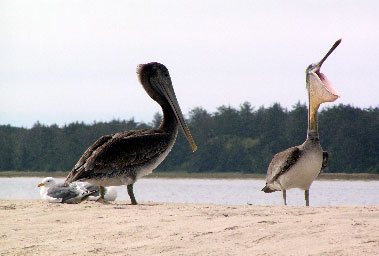|
 The beginning lines of this limerick by Dixon Lanier Merrit are certainly true. The pouch of the lower bill can hold up to three gallons, three times as much as the stomach. A big, social, gragarious, coastal bird, weighing up to ten pounds and having a wing span to eight feet, Pelicanus occidentalis arrives in the Netarts area by the hundreds around July or August and departs in the fall to Southeren California and beyond to winter and nest on offshore rocks. It is a fish eater, preying on small fish by flying 60 or 70 feet above the water and, using its excellent eysight to spot a school, plunges out of the sky in a twisting dive to scoop the fish into its lower bill like a dipnet. It then forces the water from its catch out the corners of its mouth before it swallows. If the catch is too large for its stomach, it can store the excess in its esophagus to be eaten later. Juveniles, like those pictured, are mostly brown with a lighter breast. Breeding adults develop a pattern of colors that include yellow on the top of the head, white and dark brown on the neck, and a redish bill-pouch. Pelicans are kin to the cormorant, their feet having all four toes webbed, three in front like a duck, plus the web stretching around to the fourth toe on the back of the foot. They are often grouped on the beach with seagulls and sometime cormorants, but are a little more skiddish than gulls and will shy away or fly off when approached too closely. The beginning lines of this limerick by Dixon Lanier Merrit are certainly true. The pouch of the lower bill can hold up to three gallons, three times as much as the stomach. A big, social, gragarious, coastal bird, weighing up to ten pounds and having a wing span to eight feet, Pelicanus occidentalis arrives in the Netarts area by the hundreds around July or August and departs in the fall to Southeren California and beyond to winter and nest on offshore rocks. It is a fish eater, preying on small fish by flying 60 or 70 feet above the water and, using its excellent eysight to spot a school, plunges out of the sky in a twisting dive to scoop the fish into its lower bill like a dipnet. It then forces the water from its catch out the corners of its mouth before it swallows. If the catch is too large for its stomach, it can store the excess in its esophagus to be eaten later. Juveniles, like those pictured, are mostly brown with a lighter breast. Breeding adults develop a pattern of colors that include yellow on the top of the head, white and dark brown on the neck, and a redish bill-pouch. Pelicans are kin to the cormorant, their feet having all four toes webbed, three in front like a duck, plus the web stretching around to the fourth toe on the back of the foot. They are often grouped on the beach with seagulls and sometime cormorants, but are a little more skiddish than gulls and will shy away or fly off when approached too closely.
|

